The outreach plan included efforts to reach our secondary audience of public historians and cultural heritage professionals. We began by announcing the project launch on network to reach gallery, library, archives, and museums museum professionals (GLAMs) on GLAM-Tech listservs (e.g. Archives & Archivists, DIGLIB, MUSEUM-L, MCN-L), and H-Public. Equally important in the project’s earliest days were postings to RRCHNM’s institutional blog, the George Mason Newsdesk, and the project team’s personal blogs and social media networks.
Throughout the project, the directors and associates presented Histories at conferences and authored guest blog posts on professional association websites. A few examples of these efforts are listed below:
- November 2013: Co-Director Sheila Brennan presented at the 41st Annual Museum Computer Network Conference, giving a preview of the site during a case study showcase.
- November 2013: Project Manager Megan Brett and Project Associate Lindsey Bestebreurtje co-presented a paper on “Lesser-known sites of the National Mall” for the 40th Annual Conference on D.C. Studies.
- March 2015: Brennan wrote a guest post for the NCPH blog, History @ Work, and discussed the project’s genesis and rationale behind design decisions that shaped the content, navigation, and structure of the site.
- March 2015: Co-Director Sharon Leon wrote a guest post on the American Association of Historians blog, AHA Today, and contextualized the need for historical interpretation on the Mall and explained the choice to build a mobile-first website, rather than a native application.
- July and August 2015: Brett gave two talks at the Smithsonian National Museum of American History for curatorial and archives staff, as well as for information desk volunteers. She described the process of building Histories, the decision to be mobile-first rather than build an app, and highlighted the content.

Project members distributed stickers at conferences and presentations, and placed them on their personal laptops to publicize the site. Stickers were popular with colleagues who often grabbed a stack to pass along to their professional and personal networks.